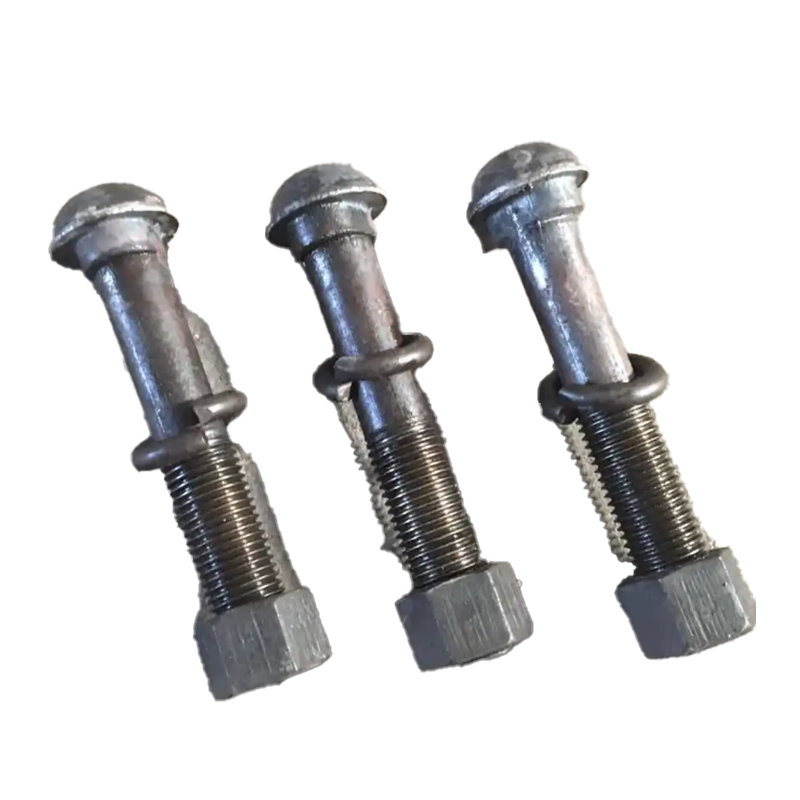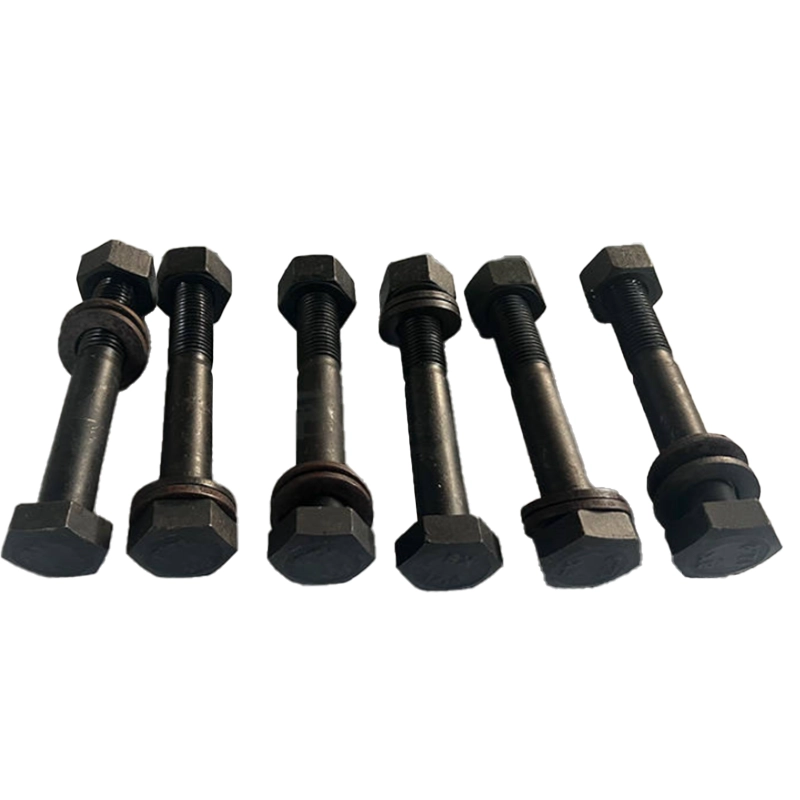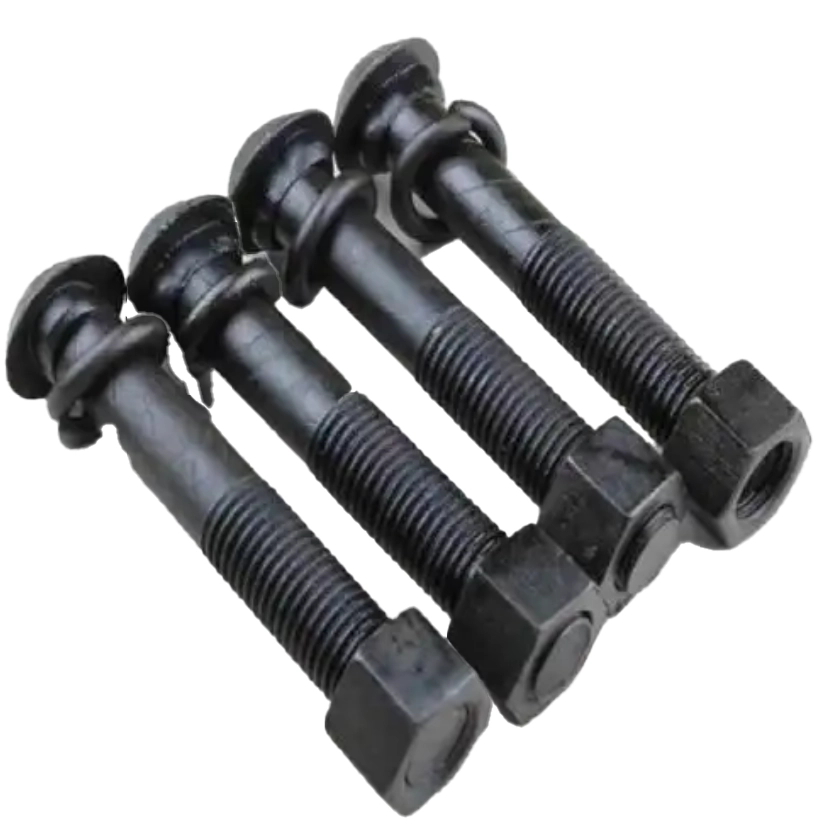Fish bolts for Mining Rail
Overview
This series of fish bolts are the critical fasteners that connect the fishplate (splice plate) to the rail. They are engineered to: distribute joint loads uniformly, resist impact and vibration from rolling stock, and maintain performance in high-humidity, highly corrosive, and wide temperature-range environments. Material selection and surface treatment can be customized for the on-site rail profile, axle load, operating speed and environmental conditions.



Materials & Corrosion Protection
Carbon Steel (Q235)
Cost-effective and suitable for non-critical or auxiliary roadways. Requires effective corrosion protection (hot-dip galvanizing, Zn-Ni plating, electrophoretic coating, or organic topcoat) to extend service life.
Medium Carbon Steel (40#)
Higher carbon content than Q235; good machinability. Proper heat treatment (normalizing/tempering, or quenching & tempering where specified) can improve strength and toughness. Suitable for medium loads where corrosion resistance is not critical; must be paired with protective coatings and fatigue testing.
Medium-High Carbon Steel (45#)
After quenching & tempering or normalization + tempering, offers higher tensile strength and wear resistance. Recommended for components requiring greater strength or wear resistance under moderate corrosion conditions.
Alloy Quenched & Tempered Steel (40Cr, Q&T / tempered & normalized)
Significantly improved tensile and fatigue performance after quenching & tempering. Recommended for heavy-load main roadways and critical lines. In highly corrosive or sulfur-containing environments, apply hydrogen-embrittlement mitigation or consider more corrosion-resistant materials.
Austenitic Stainless Steel (316L)
Preferred for extreme corrosion environments (sulfur-bearing, chloride-bearing, coastal). Excellent corrosion resistance but higher cost — recommended for high-risk service conditions.
Surface Treatments (optional): hot-dip galvanizing, Zn-Ni electroplating, three-layer composite coatings (wear layer + metallic anti-corrosion layer + organic sealing/topcoat), phosphating, etc. For sulfur/H₂S exposure, prioritize 316L or use PTFE / anti-sulfur coating systems.
Note: 40# and 45# are carbon steel grades that require appropriate heat treatment and surface protection to achieve reliable life in high-fatigue or high-corrosion mining environments.
Structural & Fatigue Design Highlights
Reinforced Hole Collar: Reduces stress concentration around bolt holes and delays crack initiation.
Ribbed / Stiffener Geometry: Increases bending stiffness at the joint and reduces local deformation.
Transition Variable-Curvature Fishplate: Optimizes joint impact response and reduces peak impact acceleration.
Standards & Certification
We can supply documentation and testing per requested standards.
Domestic references: GB/T 3098.1 (mechanical properties of fasteners), TB/T 2347 (high-strength bolts for rails), MT/T 238.1 (insulated bolts), etc.
International references: UIC series, BS standards (export projects can be executed per the applicable standard).
Factory documentation available on request: material certificates (COA), third-party tensile / fatigue / salt-spray / low-temperature test reports and associated conformity certificates.
Service Conditions & Selection Guidance (Purchase Guide)
Auxiliary Roadway / Low Corrosion: Q235 hot-dip galvanizing (economical option).
Medium Load: 40# or 45# (quenched/tempered and coated).
Heavy-Load Main Roadway / Critical Lines: 40Cr (quenched & tempered) + Zn-Ni plating or other high-durability treatment.
High Corrosion / Sulfur-Bearing / Coastal: 316L stainless steel (or 40Cr with specialized anti-sulfur coating and frequent inspection).
When ordering, please provide: rail profile (kg/m), maximum axle load, operating speed, environmental corrosion level (IP/salt-spray/hydrogen sulfide information), and desired maintenance interval. We will propose the optimal configuration and provide a quotation based on these parameters.
FAQs
Q:Can 40# / 45# replace 40Cr?
A: Through proper heat treatment, 40# / 45# can achieve higher strength, but they differ from alloy 40Cr in fatigue toughness, ductility and reliability under high-stress conditions. For critical or high-fatigue applications we recommend 40Cr (quenched & tempered) or validation via on-site testing before substitution.
Q: Which material is recommended for sulfur-bearing mines?
A: 316L stainless steel is preferred. If high-strength carbon or alloy steel is used, apply specialist anti-sulfur coatings and enhanced inspection programs; also consider hydrogen-embrittlement mitigation measures.
Q: Can hole spacing, reinforcement geometry or surface treatment be customized?
A: Yes. Provide rail profile drawings, operating parameters and environmental description and we will propose a customized solution and engineering assessment.